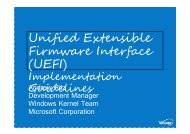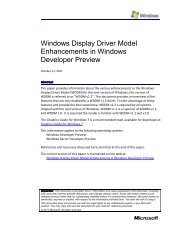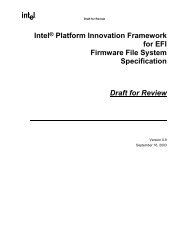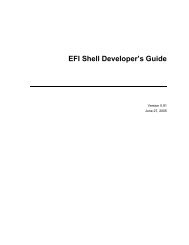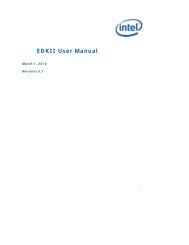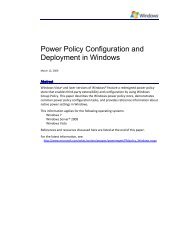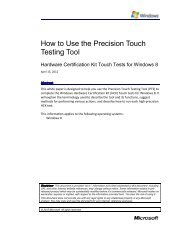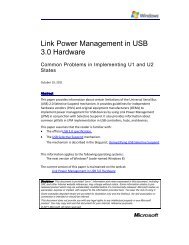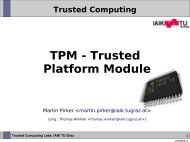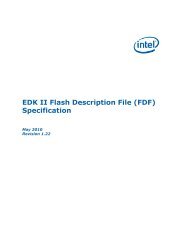TW04015_WINHEC2004.pdf
TW04015_WINHEC2004.pdf
TW04015_WINHEC2004.pdf
Create successful ePaper yourself
Turn your PDF publications into a flip-book with our unique Google optimized e-Paper software.
ACPI Table Overloading3
ACPI Table Overloading• What is it?• ACPI table overloading allows overloading / replacing a ACPItable that is in ROM, by adding a modified table of the same nameto a specific location in the registry• Why would you want to do that?• This feature allows platform developers to quickly test changes tothe BIOS code without flashing a new image to the ROM• What do you need to overload tables?• ASL.exe (version 2.02 or greater)http://www.microsoft.com/whdc/hwdev/tech/onnow/default.mspx• Have a checked ACPI.sys loaded on the target system4
ACPI Table Overloading• How to overload existing ACPI BIOS tables• Build the new BIOS ASL code (e.g. foo.aml )• Use the 2.0 ASL compiler’s s table load option (version 2.02 orgreater) to load the new .AML file into the registry• ASL.exe /acpiloadfoo.aml• The new BIOS loads when the system reboots• How to get back to the original ACPI tables?• Going back to the ROM tables can be achieved in one of twoways:• Use the “Last known Good configuration” feature of Windows to goback to a working registry• Use the Delete Registry Table feature of ASL.exe• ASL.exe /acpiload/d foo.aml5
ACPI To WMI Mapper6
ACPI To WMI Mapping Driver(wmiacpi.sys)• What is it?• Enables an interface between ACPI and Windows Management Instrumentation(WMI)• WMI objects and methods can be accessed through user-mode COM applicationsand scripts• What does it do?• Allows access to ACPI methods and namespace objects from user-mode withoutrequiring a special driver• What are some if the things it can be used for?• Testing• Initiate specific method execution• Query ACPI named objects• Expose CMOS and BIOS configuration settings• More informationhttp://www.microsoft.com/whdc/hwdev/driver/WMI/wmi-acpi.mspx7
ACPI Verifier8
ACPI VerifierWhat is it?• ACPI Verifier (ACPIVer(ACPIVer) ) is a real timeACPI namespace verifier• Determines if system BIOS is compliant with ACPIWhere is it used?• The ACPI Verifier is available in allof the WHQL HCT System kits• Mobile• Desktop• Server• All kits run the same ACPI Verifier tests9
ACPI VerifierWhy should I care?• Uncovers subtle hard to detect BIOS errors• Helps in verifying system’s s ACPIspecification compliance• Up to Revision 2• Required for Designed forWindows Logo systems10
ACPI VerifierHow do I use it?• Download the System HCT kit you are interested in getting a logo in• http://www.microsoft.com/whdc/hwdevwhdc/hwdev• Install and launch the kit• The kit displays two panes in its window• Left pane displays a list of tests• Choose ACPI Verifier from this list• Run test• This will cause ACPI Verifier to install and reboot the system• After it has rebooted ACPI Stress is run to cycle the system in and out of sleep states• Once it has finished a log is produced• The log will contain any failures that ACPI Verifier found• To determine what objects are causing these problems you need to hook up akernel debugger to the system and re-run the test. More verbose loginformation will be provided in the debugger and this will allow you to begindebugging any failures11
ACPI VerifierHow does it work?• The ACPI Verifier is a passive real timenamespace verifier• It monitors the AML Interpreter• Performs verifications12
Debugging ASL / ACPI13
Debugging ASL / ACPI!amlihelpkd> > !amli!?• Help - ? []• Clear Breakpoints- bc | *• Disable Breakpoints- bd | *• Enable Breakpoints - be | ...• Request entering debugger- debugger• Dump Name Space Object- dns [[/s] [ > |
Debugging ASL / ACPI• For more information on AML debugger commands lookin the debugger help file or type !amli? Example:kd> !amli!? SetSet Debugger Options:Usage: set [traceon[| traceoff] ] [nesttraceon[| nesttraceoff][spewon| spewoff] ] [lbrkon[| lbrkoff] ] [errbrkon[| errbrkoff][verboseon| verboseoff] ] [logon | logoff] [logmuton[| logmutoff]15
Debugging ASL / ACPITwo Ways to Debug AML1) Using the extension• Break in to kd and use:!amli2) Debugging at the AMLI prompt(AMLI(? for help)->)• All the same commands from the extension can be used at this prompt.Use the commands without prefixing them with !amli!• There is an additional set of commands available that can only be used atthis prompt. Type “?” at this prompt to get the full list16
Debugging ASL / ACPIWhy Are There Two Ways To Do The Same Thing?• The extension is a good tool to get general informationsuch as dumping ACPI name space, un-assemblingmethods, setting breakpoints, etc.• Some things can only be done from within the context ofthe interpreter. Example: Stepping through AML code asit executes. To force the interpreter to break in at the“AMLI(? for help)->” prompt, break into kd and use“!amlidebugger”, , or set a breakpoint on a particular AMLmethod you are interested in debugging17
Debugging ASL / ACPISome useful commands and what they do• Debugger• Causes the interpreter to break in at a “AMLI(? for help)->” prompt whenever the interpreter is activated to evaluate anything. Use this command atthe regular kd prompt and then hit go (g).(The Interpreter will break in thennext time it is activated• Set (spewon(spewon, verboseon, traceon, errbrkon)• Spewon: : Enables debug output from the interpreter• Verboseon: : Lists the names of methods as they are evaluated• Traceon: : Similar to “verboseon” but much more verbose. This is veryhelpful in tracking SMI related hard hangs• errbrkon: : Will cause the interpreter to break in at the “AMLI(? for help)->”prompt when it encounters any errors while evaluating AML18
Debugging ASL / ACPI• Find• searches for methods, field units etc in the acpi name space and lists them withtheir full path• DnsAMLI(? for help)-> find _srs_\_SB.LNKA._SRS\_SB.LNKB._SRS\_SB.LNKC._SRS\_SB.LNKD._SRS• The Dump Name Space command is useful in determining what a particular namespace object is (method, fieldunit, , device etc). This command can be used to dumpthe entire name space, a sub tree or a particular objectAMLI(? for help)-> dns \biosACPI Name Space: \BIOS (80E5F378)OpRegion(BIOS:RegionSpace=SystemMemorySystemMemory,Offset=0xfcb07500,Len=2816)19
Debugging ASL / ACPI• uUnassembles a given full path (e.g.: \_SB.LNKB._SRS) or a given addressExample:kd> !amli!u \_SB.LNKA._CRSOrkd> !amli!u ffffffff80e5d701ffffffff80e5d701 : CreateWordField(CRES, 0x1, IRQW)ffffffff80e5d70c : And(\_SB_.PCI0.LPC_.PIRA, 0xf, Local0)ffffffff80e5d723 : Store(One, Local1)ffffffff80e5d726 : ShiftLeft(Local1, Local0, IRQW)ffffffff80e5d72d : Return(CRES)20
Debugging ASL / ACPI• rDumps the current context of the interpreter. This is a very useful command touse when the interpreter breaks in at the “AMLI(? for help)->”. Example:kd> !amli!rMethodObject=\_WAKffffffff80e0ff5c: Local0=Unknown()ffffffff80e0ff70: Local1=Unknown()ffffffff80e0ff84: Local2=Unknown()ffffffff80e0ff98: Local3=Unknown()ffffffff80e0ffac: Local4=Unknown()ffffffff80e0ffc0: Local5=Unknown()ffffffff80e0ffd4: Local6=Unknown()ffffffff80e0ffe8: Local7=Unknown()ffffffff80e0e040: RetObj=Unknown()Next AML Pointer: ffffffff80e630df:[\_WAK+16]ffffffff80e630df : If(S4BWffffffff80e630e5 : {ffffffff80e630e5 : | Store(Zero, , S4BW)ffffffff80e630eb : }21
Debugging ASL / ACPIBreakpoint commands (bp(bp, bc, , be, bd, bl)• Used to set clear, enable and disable breakpoints within AML methodskd> !amli!bl0: ffffffff80e5e2f1:[\_SB.LNKD._SRS]1: ffffffff80e5d969:[\_SB.LNKB._STA]2: ffffffff80e630c9:[\_WAK]3: ffffffff80e612c9:[\_SB.MBRD._CRS]22
Debugging ASL / ACPILC - List current contexts:AMLI(? for help)-> lcCtxt=80e3f000,ThID=00000000,Flgs=A--C-----,pbOp=00000000,Obj=\_SB.LNKA._STACtxt=80e41000,ThID=00000000,Flgs=A--C-----,pbOp=00000000,Obj=\_SB.LNKB._STACtxt=80e9a000,ThID=00000000,Flgs=A--C-----,pbOp=00000000,Obj=\_SB.LNKC._STACtxt=80ea8000,ThID=00000000,Flgs=A--C-----,pbOp=00000000,Obj=\_SB.LNKD._STA*CtxtCtxt=80e12000,ThID=80e6eda8,Flgs=---CR----,pbOp=80e5d5ac,Obj=\_SB.LNKA._STAFlags:A – Asynchronous evaluationN – Nested EvaluationQ – In the ready queueC – Needs a callbackR – RunningW - ReadyT – TimeoutD – Timer dispatchP – Timer pending23
Debugging ASL / ACPIOther useful extensions!acpiinf– ACPI informationACPIInformation (823eaf40)RSDT- f8b0c548FADT- f8b0eb2eFACS- f8b0ffc0DSDT- f89c2574GlobalLock- f8b0ffd0GlobalLockQueue - F - 823eaf58 B -823eaf58GlobalLockQueueLock - 00000000GlobalLockOwnerContext - 00000000GlobalLockOwnerDepth - 00000000ACPIOnly- FALSEPM1a_BLK - 00008000 (0400) (0321)400 - RTC_STS1 - TMR_EN 20 - GBL_EN 100 - PWRBTN_EN 200- SLPBTN_ENPM1b_BLK- 00000000 (N/A)PM1a_CTRL_BLK - 00008004 (0005)1 - SCI_EN 4 - GBL_RLSPM1b_CTRL_BLK- 00000000 (N/A)PM2_CTRL_BLK- 00000000 (N/A)PM_TMR- 00008008 (0031e15b)GP0_BLK - 00008020 (00) (00)GP0_ENABLE - 00008022 (00) (00)GP0_LEN - 00000004GP0_SIZE - 00000002GP1_BLK- 00000000 (N/A)GP1_ENABLE - 00000000 (N/A)GP1_LEN - 0GP1_SIZE - 0GP1_BASE_INDEX- ffffGPE_SIZE - 2PM1_EN_BITS - 03211 - TMR_EN 20 - GBL_EN 100 - PWRBTN_EN 200 -SLPBTN_ENPM1_WAKE_MASK - 0000C2_LATENCY - 0C3_LATENCY - 0ACPI_FLAGS - 0ACPI_CAPABILITIES - 024
Debugging ASL / ACPI• Other useful extensions• !FADT – Dumps the FADT• !RSDT – Dumps the RSDT• !FACS – Dumps the FACS• !MAPIC – Dumps the APIC25
Common ASL ErrorsAnd Solutions26
Common ASL ErrorsAnd SolutionsPCI IRQ Routing (PIC vs. APIC mode)• If the _PIC control method is present, the _PRT method should return interruptrouting information based on the value _PIC was called withMethod(_PIC,1){Store(Arg0, PICS)}Method(_PRT){if (PICS){…}else{…}}_PIC(0) => PIC Mode_PIC(1) => APIC Mode27
Common ASL ErrorsAnd SolutionsFADT Version• Revision 2 FADT was introduced for Legacy Free systems. It wasalso modified to support ACPI 2.0 Processor Performance Statesand C-State support• For complete field definition of Revision 2 FADT table, seeMicrosoft’s s Legacy Free document and Windows XP NativeProcessor control document• http://www.microsoft.com/whdc/hwdev/tech/onnow/procperfctrl.mspxwhdc/hwdev/tech/onnow/procperfctrl.mspx• If Revision 3 is used in the FADT table then the proper lengthmust be set28
Common ASL ErrorsAnd SolutionsDivide By Zero• The following code can potentially cause a divide by zero error:Store(SMSC, , Local0)Store(SMLN, , Local1)Divide(Local0, Local1, Local2, Local3)• It is better to check the value of Local1 before calling Divide:Store(SMSC, , Local0)Store(SMLN, , Local1)If(Local1){Divide(Local0, Local1, Local2, Local3)}29
Common ASL ErrorsAnd SolutionsAvoid Possible Infinite Loop• The following code can potentially be stuck in an infinite loop if the hardwarehas a error:While(SMST){Sleep(0x2)}• It may be better to check the return x number of times, then break out of theWhile loop:Store(20, Local2)While(Land(SMST, , Local2)){Decrement(Local2)Sleep(0x2)}30
Common ASL ErrorsAnd SolutionsUse _REG to Check EC StatusDevice(EC0){Name(REGC,Ones) // REGC is a Named object initialized with onesMethod(_REG,2){// _REG control methodIf(Lequal(Arg0, 3)){Store(Arg1, REGC)}} // end of _REGMethod(ECAV,0){ // ECAV control methodIf(Lequal(REGC,Ones)){If(LgreaterEqual(_REV,2)){Return(One)}Else{Return(Zero)}}Return(REGC)}}31
Common ASL ErrorsAnd SolutionsASL code can check the availability of the ECOperation Region as follows:If (\_SB.Pci0.Ec0.ECAV()){...Regions are available...}Else{...Regions are not available...}32
Common ASL ErrorsAnd Solutions_OSI• Windows XP implements a new Method called _OSI. A white paper with detailson _OSI is available from:http://www.microsoft.com/whdc/hwdev/tech/onnow/_osi-method.mspx• _OSI accepts a string as its only parameter. This string tells the OS which OSversions are supported by the BIOS. This way the OS can maintaincompatibility with older BIOS and exposes new features to newer BIOS• Currently _OSI accepts the following strings:• “Windows 2000”• “Windows 2001”• “Windows 2001 SP1”• “Windows 2001.1”• “Windows 2001 SP2”• “Windows 2001.1 SP1”• The following new string is being added for Longhorn:• “Windows 2006”33
Common ASL ErrorsAnd Solutions• Windows XP checks for certain operations that are deemed unsafe, asthey can cause system instability. If these operations are detected,Windows XP logs an event log entry and in some cases prevents theoperation• The following is a list of some of the operations considered unsafe:• Accessing CMOS registers(0x70-0x71) and PCI Config Space(0xCF8 – 0xCFC) via an SystemIO Operation Region. A completelist of IO ports considered unsafe to access via SystemIO OperationRegions can be found in a white paper titled “I/O Ports Blocked fromBIOS AML on Windows XP”• Creating a SystemMemory Operation Region in address ranges thatwere reported by INT 15 function E820 as reserved for the OS(AddressRangeMemory). With the exception of the 1 st page ofphysical memory34
Common ASL ErrorsAnd SolutionsS4 RTC Wake• In order for RTC wake to work when themachine is in S4, the RTC_S4 flag must beset within the FACP table (if set HIGH, thenthe platform supports RTC wakeup in theS4 state)35
Common ASL ErrorsAnd SolutionsOrder of Operations• The Operating System does not guaranteeany specific calling order for ASL methods,unless otherwise specified in the ACPIspecification. Therefore, the BIOS writershould not expect any specific sequence inwhich control methods would get called36
Common ASL ErrorsAnd SolutionsThermal Zones Should Be Real• All systems that have thermal zones musthave real hardware (thermal sensors) tosupport the methods provided. I.e., if aBIOS has a _TMP method then the OSexpects that it will return valid data37
Common ASL ErrorsAnd SolutionsDo not issue Notify() to power button tocause monitor to turn on• When a machine wakes due to an PME# eventor a remote event, BIOS ASL code should not doNotification on the fixed feature power button inorder to wake the monitor38
Common ASL ErrorsAnd Solutions_PRW may not be empty• Must evaluate to a package withat least 2 elements• Bit index in GPEx_EN of enable bit armed for wake• Lowest system power sleep state that allows wake39
Common ASL ErrorsAnd SolutionsPotential problems with PAE(Physical Address Extension) mode• Systems may run in PAE mode more often with less than4GB of RAM as PAE mode is a requirement of the NX(No Execute) feature• Execution protection (NX, or no execute) is an operating systemfeature that relies on processor hardware to mark memory with anattribute indicating that code should not be executed from thatmemory. Execution protection functions on a per-virtual memorypage basis, most often leveraging a bit in the page table entry(PTE) to mark the memory page40
Common ASL ErrorsAnd SolutionsPotential problems with PAE(Physical Address Extension) mode• Microsoft has seen BIOS and PAE incompatibilities• Engagement with some OEMs has led to concerns about SMIhandling routines• Some SMI handling routines attempt to decode the last instructionexecuted by the OS to determine attempted action (IO Port Write)• BIOS has a 32-bit virtual address and attempts to walk PTE’s todiscover 32-bit Physical Address and actual instruction opcode• PTE’s are 64-bits long in PAE mode, leading to incompatibility• Most common observed behavior is hard lock or spontaneous reboot41
Common ASL ErrorsAnd SolutionsPotential problems with PAE(Physical Address Extension) mode• Corrective action:• Use processor manufacturer prescribed steps to determine IOaddress. (Apparently most processors keep this information aroundin a structure accessible while in SMM)• AMD BIOS writer's guide: “BIOS and Kernel Developer’s s GUID forAMD Athlon 64 and AMD Operton Processors” located athttp://www.amd.com/us-en/assets/content_type/white_papers_and_tech_docs/26049.PDF• Contact Intel for documentation42
Common ASL ErrorsAnd SolutionsHardware layout does not match the ACPInamespace layout• We have seen a few cases related to Hot Plug controllersand Slices, where an ACPI device or its methods have adependency to devices that are not its parent or in itsparents hierarchy• This is sort of representation can lead to seriousproblems because the Operating system does notunderstand or respect these dependencies43
Common ASL ErrorsAnd SolutionsSB• In this name space representation we seethat the value returned by the _STA methodunder the COM1 device changes after the_INI method under the SLCE device isevaluated• This can cause problems and suchdependencies should not be created• One possible workaround to resolve thisissue may be to create a method underSLCE, Lets’ call it DPND, that can be calledfrom the COM1 _STA• DPND could do the necessary initializationso that COM1._STA can return the correctdata every timePCI0LPCSLCE_STACOM1_INI44
Some Upcoming ChangesIn The ACPI Driver45
Some Upcoming ChangesIn The ACPI Driver• For Windows XP SP2, a mechanism has been added that improvesperformance in the ACPI interrupt handling code• Windows XP had a problem whereby if other devices were sharing theACPI interrupt, performance degradation could occur• This happened due to a delay by the ACPI driver in passing the interruptto the proper handler• This feature is not “on” by default in Windows XP SP2 because ofbackward compatibility concerns• This feature will be “on” by default in Longhorn• To enable this feature on Windows XP SP2:• OpenHKEY_LOCAL_MACHINE\System\CurrentControlSet\Services\ACPI\Parameters• Edit or add a DWORD value named “Attributes”• Bitwise OR 0x00000100 into the “Attributes” value• Restart the system46
Some Upcoming ChangesIn The ACPI Driver• ECDT support in Longhorn• For Windows XP an ACPI BIOS has to wait for the OSto Call the _REG method before it can start accessingEC operation regions via ASL. This limitation will nolonger exist in Longhorn• Platform vendors can simplify BIOS code by providingthe ECDT table• This table will cause longhorn to load EmbeddedController operation region support as soon as theAML interpreter is ready to execute code47
Additional Resources• Email• aslhelp @ microsoft.com – Writing ASL, debugging, general ACPI questions• onnow @ microsoft.com – Windows Power Management Questions• Web Resources:• ACPI and Windows Power Managementhttp://www.microsoft.com/whdc/hwdev/tech/onnow/default.mspxwhdc/hwdev/tech/onnow/default.mspx• ACPI Specification: http://www.acpi.info48



